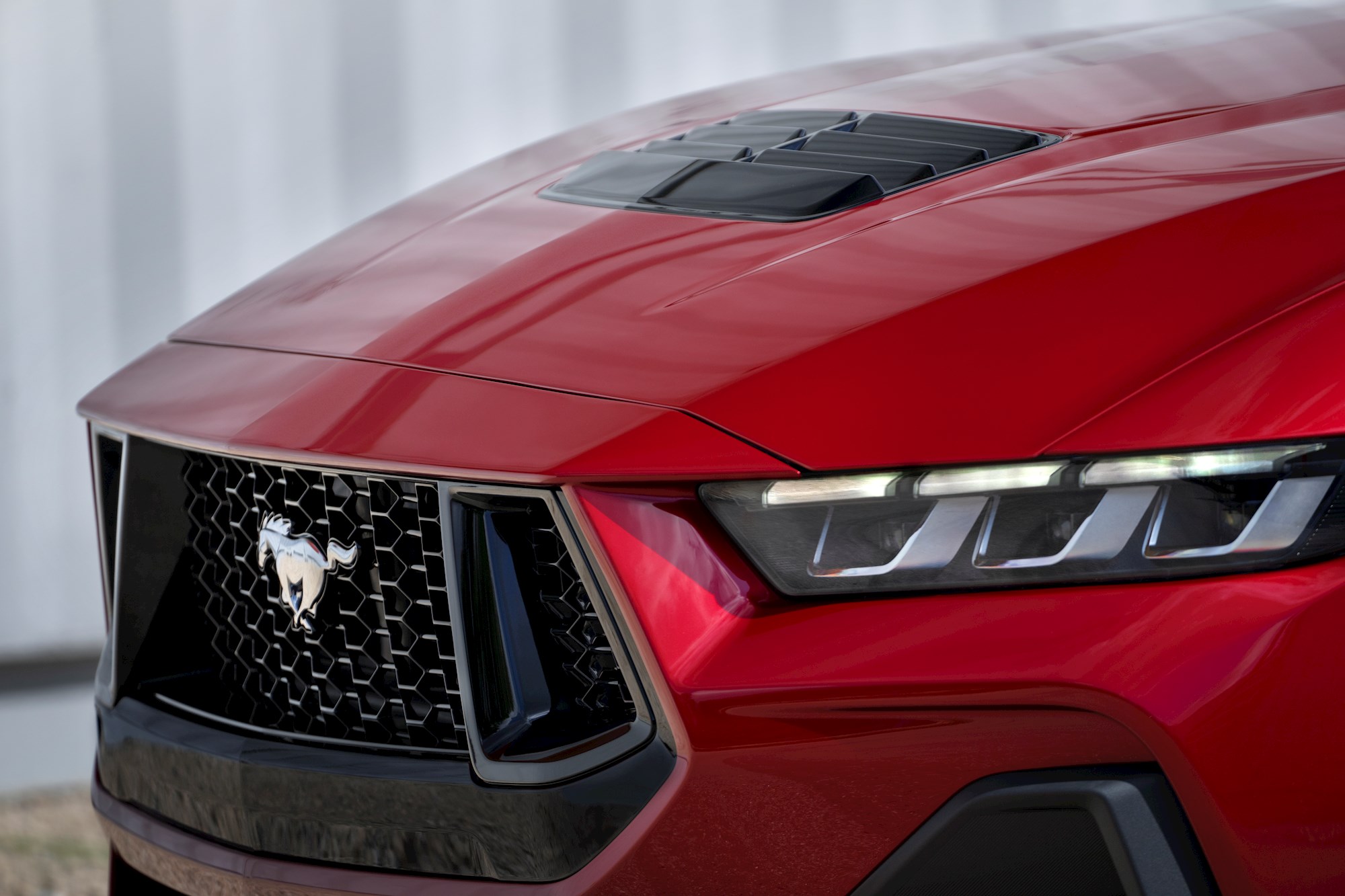Ford’s Mustang has gone pure-electric in Mach-E SUV form, but that doesn’t mean the traditional models are on their way out. The company says it’s also still committed to the internal combustion engine for its Pony car for now, and here’s the proof: the seventh-generation Mustang coupe and convertible, launched at the North American International Auto Show (NAIAS) on September 14.
It’s based on the platform of the sixth-gen car (launched in 2015, the first factory right-hand drive Mustang) and is powered by updated iterations of the existing 2.3-litre Ecoboost turbo-four and 5.0-litre V8 Coyote V8 engines. Ford is promising more power from both, but hasn’t released final output figures - although 483bhp (360kW) was mentioned at the launch event in Detroit for the V8, a potential increase of 21kW over the outgoing car.

There's also a new range-topper called Dark Horse (see gallery below) - a surprise announcement at the Detroit launch event. It's a track-capable model with 373kW and enhanced handling and aero, and will be joining the Kiwi range.
“Investing in another generation of Mustang is a big statement at a time when many of our competitors are exiting the business of internal combustion vehicles,” says Ford chief executive Jim Farley. “Ford, however, is turbocharging its ICE growth plan, adding connected technology, opinionated derivatives, and hybrid options to our most profitable and popular cars – all in the Ford Blue family – on top of investing $50 billion in electric vehicles through 2026.”
While the basic recipe seems familiar, Ford says the new Mustang aims to bring analogue and digital technology together in new ways, to attract a broader audience.
“Mustang represents freedom,” says New Zealand-born Alica Agius, now head of strategy and transformation for enthusiast products at Ford head office in Dearborn, Detroit.
“But perceptions around freedom are changing; we’re hearing from our customers that it now comes from technology. So if we can combine that physical freedom [of driving] with digital freedom, we have a winning combination.”

While the styling is clearly an evolution of the sixth-gen car (and therefore all the Mustangs that have come before it since 1964), the idea is to combine traditional detail with a look and feel more in tune with contemporary car culture.
“The sports car segment is changing,” says Jim Owens, Mustang brand manager. “So how do we get into the mindset of that early Millennial or Gen Z customer?
“It’s founded in that sixth generation Mustang before it, but it’s got to be edgy, sexy and disruptive, which is what this generation wants. It could be drifting culture, as opposed to just drag racing. It’s ‘gamificiation’.

“It has gone from personalisation of your vehicle to personalising your electronics.”
The former is still key, though. There are new colours and buyers will be able to co-ordinate the finish of the Brembo brake calipers (now branded with Mustang logos) with bonnet stripes, for example. Coloured seatbelts are a first for Mustang.
On the outside, the Mustang has been cleaned up and made more aggressive, with a higher beltline and sharper angles (note the deep cutout along the tail-light panel). For the first time, there’s substantial styling differentiation between the four and eight-cylinder models at the front: different grille and bumper shapes, with gloss black on the V8, larger inlets and a bonnet (sorry, “hood”) vent that is fully functional, says Ford.

It’s on the inside where analogue and digital truly come together. For the first time, the iconic “double brow” dashboard is gone. Instead, there are dual screens, angled towards the driver.
In base models the two displays stand alone; in upper-specification versions they are united behind a single glass panel, for a widescreen appearance. It’s all customisable, in line with that “gamification” of automotive interior design.
But some of the new instrument-cluster graphics are also a nod to the past, even down to a night theme that echoes the simple layout and green colour of the 1980s Fox Body Mustang.

Many basic functions have been moved into the digital environment – climate control, for example – but there’s still a three-spoke deep-dish steering wheel and in Performance Pack versions, a conventional-looking handbrake that’s actually an electronic “drift brake” for track use.
Ford says it’s light and responsive, with up to five times more pressure than a mechanical brake, designed to really help everyday drivers learn the art of sideways driving. It was developed with the help of Ford Performance-sponsored champion drifter (and RTR creator) Vaughn Gittin Junior.

Given the controversy over the “line lock” burnout feature in the sixth-gen Mustang, which was deleted in Australasian models, it will be interesting to see whether the drift tech makes it here.
We won’t know any of the fine detail for a while yet. The new Mustang doesn’t go on sale in the US until mid-2023, so it’ll be a late-year arrival for New Zealand.























